Question: What are the different types of train cars on MAX? Part 4
The Type 4s are the newest cars in the fleet, having entered passenger service in August 2009.
Type 4 – cars 401 through 422
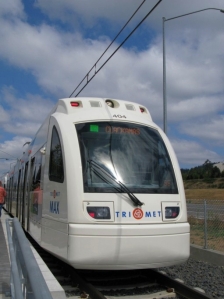 Also known as “those shiny new ones.”
Also known as “those shiny new ones.”
These are very different from the Type 1, 2, and 3 cars! Color-wise, they all have the new TriMet color scheme, and like the Type 3s, external ads are limited to a small part of the outer body (typically the ads I’ve seen on the 4s are TriMet specific ads, such as promoting the WES service). The Type 4s use LED displays for the destination signs (compared to the scrolling signs of the older trains). These are manufactured by Siemens and were first put into service in 2009 to coincide with the Green Line alignment opening.
Because each Type 4 car has only one cab, they will only ever be coupled with another Type 4 and you won’t see a single car Type 4 train. Each type 4 has a folding coupler head located under the cab that permits it to be coupled to a Type 1, 2, or 3, but that is only ever used if the Type 4 train needs to be towed or pushed somewhere while out of service – it will never be coupled to one of the older fleet in service.
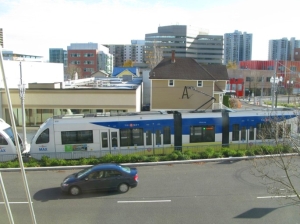 Type 4 train leaving the Jackson Street turnaround by PSU
Type 4 train leaving the Jackson Street turnaround by PSU
The layout inside is also changed from the older cars. Similar to the Type 2s and 3s, there is an upper deck near the cab, behind which are bike racks and then a priority seating area for people with mobility devices or other physical impairments. Then the C-Section (the middle part) of the train has seats arranged face-to-face, somewhat similar to the seating arrangement in a Type 1 and different from the sideways-facing seats in the C-Section of the Type 2s and 3s.
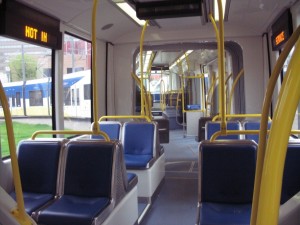 Looking towards the rear of the car from the middle
Looking towards the rear of the car from the middle
Then in the back of the car is the “parlor” – this is where the second cab of the train should be, but instead there is additional seating and big windows like the windshields of the cabs.
Even though the 4s are shiny and new and I think they are impressive looking, I’m not really a fan of them on a practical design level.
Some seats are very cramped: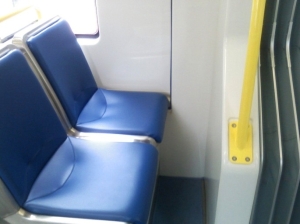 Good luck comfortably fitting two full-grown adults in there!
Good luck comfortably fitting two full-grown adults in there!
There are a lot of tripping hazards: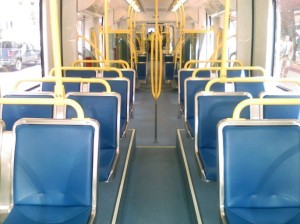 I’ve seen people trip on that ledge on either side of the aisle between the seats, especially when the train is crowded. In the older fleet, there is no step between the aisle and the seating. Also, though it’s a bit hard to see in the photo above, that aisle slopes down at the end towards the center of the train, which catches a lot of people off guard making them stumble. The above picture was taken before the 4s were put into service – yellow tape was placed on the floors around the tripping hazards, which was great for the first week or so. But now that tape is sort of a muddy brown-grey color, so it’s not really effective to draw people’s attention to changes in the floor.
I’ve seen people trip on that ledge on either side of the aisle between the seats, especially when the train is crowded. In the older fleet, there is no step between the aisle and the seating. Also, though it’s a bit hard to see in the photo above, that aisle slopes down at the end towards the center of the train, which catches a lot of people off guard making them stumble. The above picture was taken before the 4s were put into service – yellow tape was placed on the floors around the tripping hazards, which was great for the first week or so. But now that tape is sort of a muddy brown-grey color, so it’s not really effective to draw people’s attention to changes in the floor.
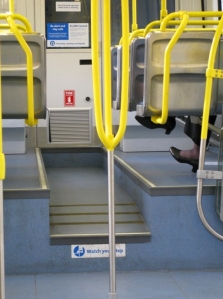 View of the aisle at the front of the train car showing the sloped tripping hazard and the once-yellow striping.
View of the aisle at the front of the train car showing the sloped tripping hazard and the once-yellow striping.
There are some areas of space that would be okay to stand in if there were lower stanchion poles to hold onto:
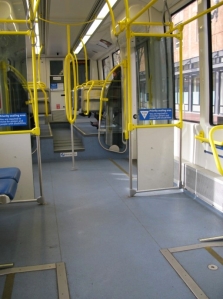 This is the priority seating area for seniors, people with disabilities, and mobility devices, where all of the overhead bars are out of reach of shorter people so it’s a lot of empty space that can be difficult to stand in if the train is crowded. I understand that there are no floor-to-ceiling stanchion poles here to allow wheelchair movement, but I prefer the design of the priority seating area from the Type 2s and 3s. Those have three sets of fold-down seating in this space and wider partitions separating this area from the bike rack where there is room for two people to easily stand or hold on. Here there is only one set of fold-down seating because the bike rack partitions are narrower, leaving room for only one person to stand there. I would have assumed that the priority seating area for seniors and people with difficulty navigating steps would have more… well, actual seating. I think this space could be better served by adding more fold-down seating that can be used as needed and folded to allow for wheelchair boarding.
This is the priority seating area for seniors, people with disabilities, and mobility devices, where all of the overhead bars are out of reach of shorter people so it’s a lot of empty space that can be difficult to stand in if the train is crowded. I understand that there are no floor-to-ceiling stanchion poles here to allow wheelchair movement, but I prefer the design of the priority seating area from the Type 2s and 3s. Those have three sets of fold-down seating in this space and wider partitions separating this area from the bike rack where there is room for two people to easily stand or hold on. Here there is only one set of fold-down seating because the bike rack partitions are narrower, leaving room for only one person to stand there. I would have assumed that the priority seating area for seniors and people with difficulty navigating steps would have more… well, actual seating. I think this space could be better served by adding more fold-down seating that can be used as needed and folded to allow for wheelchair boarding.
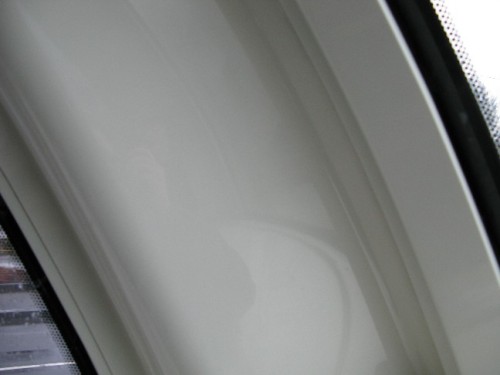 I think the giant blind spots which are much larger than the ones in the other train car types are a safety hazard.
I think the giant blind spots which are much larger than the ones in the other train car types are a safety hazard.
And I’m kind of vexed by the absence of external mirrors – operators instead look at monitors linked to external cameras to check the platform, but the picture on those can be difficult to see if the cameras are being rained on, or if it’s foggy (because those types of weather conditions obviously never happen in Portland)
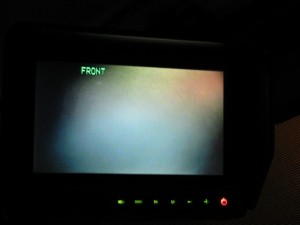 Poor visibility – at least this train also had mirrors for the operator to use
Poor visibility – at least this train also had mirrors for the operator to use
The above picture isn’t a Type 4 camera monitor, but it’s a good illustration why I don’t like relying on camera monitors alone – if your mirror gets gunked up, you can reach out and clean it. If your camera ices over like this one did during freezing fog, you lose the ability to watch that side of your train unless you also have a mirror to use. Granted, mirror visibility isn’t as critical in trains as it is for buses (since you’re not exactly going to be changing lanes with a train) but you still need to be able to see down the length of the platform to watch people boarding and exiting your train.
But there are some cool features about the Type 4s:
Seeing out the front!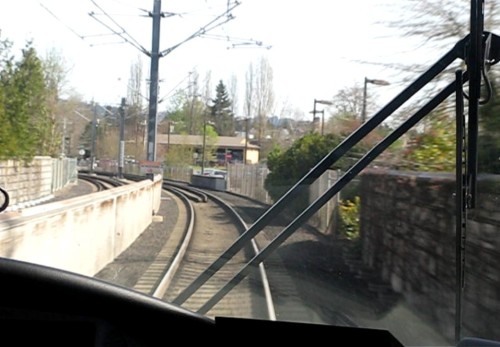 Little kids seem to really enjoy this. So do some adults.
Little kids seem to really enjoy this. So do some adults.
Seeing out the back of one car into the other car from the parlor!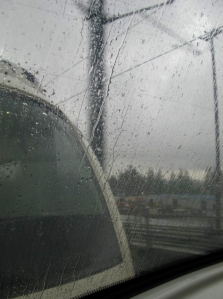 (which works better on a non-rainy day, but what can you do?)
(which works better on a non-rainy day, but what can you do?)
And the ride quality of these is extremely smooth, thanks to the ability of these trains to be set at a speed and automatically maintain it – reducing the jerkiness around curves or down hills that can sometimes be felt with the older trains in the fleet.
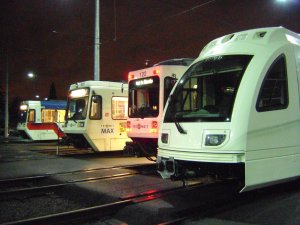 One of each.
One of each.
Photo by EMS from when she finally got her dream shot of each car type in the yard
That about wraps up the main points of the four train car types. Nowadays most MAX trains will be two cars long (one exception is the Portland Mall shuttle, which will be a single Type 2 or 3 car that runs between PSU and Union Station during the day on weekdays), with a Type 4 always coupled with another Type 4, and a Type 1 (high floor) always coupled with a 2 or a 3 (low floor). The cars are capable of functioning as train longer than two cars, but that will only happen in unusual circumstances, such as coupling a two-car train to another two-car train that is stuck or broken down in order to move it – which happened in June of 2010. The short length of Portland city blocks prohibits trains in normal service being longer than two cars – a three-car or longer train would block the intersection behind it at a platform stop.
In future entries I may go into specific detail about something particular to one car type or another, but this series of entries serves as a reference point giving an overview of the four types of train cars used in service today.


No more looking through the cab on seemingly most of the Type IVs – the operators have generally blocked the view by taping up newspaper (or whatever). While I can understand the operator’s desire for privacy, the public owns these vehicles and should at least get to peek inside to see what their millions of dollars have paid for.
Also, I think the remote control is neat, too.
Many operators wouldn’t have hung those newspaper curtains themselves, but don’t mind just leaving them up — a lot of operators had problems with passengers being distracting when the windows were uncovered. There were also some who had glare issues on their windshields at night from the lights in the passenger area of the train.
True that the trains were bought with public money, but the cabs on the older trains have been curtained for years without the public being able to see it, and that doesn’t seem to have been a problem.
The remote control is pretty neat for what it has to do! But again, functionality-wise, I think the trains would’ve been better off with a second cab in that area instead of the extra seating, even though the views from the parlor are nice. I’ve used that remote to move a type 4 car around the yard and that was enough for me – I don’t envy the mechanics that have to do that on a more regular basis since it’s very slow and very cumbersome to use – and very hard to call switches while using it!
What’s strange is that many European DMU/EMU trainsets (like of like WES) that have windows separating the passenger cabin from the cab are glass from edge to edge or pretty close to it, allowing riders a clear view forward. On some trains, the Operator has a switch that can make the glass translucent so it is not see-through…but typically it’s wide open.
I don’t get why MAX operators have a phobia of being seen…after all, most Streetcar operators I’ve been with leave their door open (one even offered to let my son sit inside the cab!), and the Vintage Trolley has no wall or partition – the cab is wide open (I wonder if the Vintage Trolley is even equipped with ATS???)
(one even offered to let my son sit inside the cab!)
Heh, they probably shouldn’t have done that..
My understanding is that the curtains went up in the older fleet due to glare from the passenger area on the window – which is very distracting in nighttime operation.
As far as I know, it’s not a rule violation for a streetcar operator to operate with the door open, since you’re right – most of them do! But it *is* technically a rule violation for rail operators to have their door anything but closed & locked while operating. There is some variability in how that is enforced, though – a senior operator permitting another operator or someone else who is rail certified (or in training) to stand in their doorway seems to be allowable. A new operator letting, say, a family member stand in the doorway is not (new operators actually can’t have *anyone* but supervisors or training staff in their cab for 90 days). And yes, I’ve seen operators leave the cab door open for passengers to watch out the front sometimes, such as in the tunnel.
On top of that, anyone actually riding in the cab – even if it’s another operator – has to be called into Control for permission. So there are a lot of rules regarding who has any kind of access to the cab, be it riding in or just standing in an open door.
So I don’t know how much of it is a phobia of being seen vs. just carrying out orders. I know some operators hate the lack of passenger interaction at rail – many end up deciding to go back to bus; others find workarounds where they can (riding with the cab windows open to chat with people on platforms, for example, and then there was another operator (now a supervisor) who made weather announcements every time his train went through Portland). Others choose to transfer to Streetcar or sign the Vintage Trolley runs during those signups.
Interesting question about ATS and the Vintage Trolley – there aren’t many ATS magnets on the route that the trolley takes, but I would imagine they would work given what they protect. I have never operated a trolley so I don’t know firsthand… they used to certify all rail operators on them, but nowadays only the people who always sign them and people who work the extraboard will be certified in trolley operation.
Pingback: Tweets that mention Types of #trimet #lightrail #train cars - -- Topsy.com
And, yes, the vintage trolleys are protected by ATS, but the streetcars are not.
Do you know how well type 4s compare to the rest of the fleet, maintenance wise?
IMO the 4s seem in worse condition lately than even the 1s. They creak A LOT, especially around turns, and the interior seems to scuff and get dirty faster. The non-referbed 1s seem in better shape!
Officially, I don’t know, but from my non-official perspective it does seem like they fall into disrepair faster. I think the bright color scheme on the interiors doesn’t help with the cleanliness part – I don’t personally like the purple paneling in the rest of the fleet but it hides wear and tear better.
I asked this on a different portion of the type 4, was wondering if anyone had found an answer yet. When a 4 is leaving a stop, or coming into one, you can hear the frequency of the motor’s changing, almost like up shifting or down shifting, happens 3 seperate times on an increase of power leaving a stop or a decrease of power coming into a stop. Anyone know why this is? It only happens on type 4’s, never heard it on any of the others.
I think it’s around the speed where the braking blends from dynamic to friction, so I’m guessing the sound is the motors switching function from generators, however I’m not sure why it’s audible on those cars and not the older ones.
That would make sense if I only heard it when slowing down. But this sound is when increasing speed as well. Next time Im on a four (hopefully never, hate 4’s) I’ll try to get a recording of it. When you going to do another post? Miss reading your stuff, :)
Thanks – and I’m not sure, some stuff in the works but not a lot of time to sit down and write…
Not really meant for the type 4 section, not sure how to do a general post. I was riding to work this morning and when we stopped at Millikan Way I glanced at the center metal pole that supports the overhead. All of these poles have plates with a 5 digit number on them, but the one at Millikan has a number and above it the name Shannon. I was east bound to Portland. I started paying attention to the others and it looks like every 10 to 12 have a name above the number. Who are these folks?
That’s not a who, it’s a what – Shannon Place is the street name there, and the other names you were seeing on the catenary poles are more of the same. Good question!
Oh, I didn’t realize that road was Shannon pl. that makes sense now. :) what about the numbers on the poles? That just for inventory and maintenance purposes?
Yeah, they’re like ID numbers.